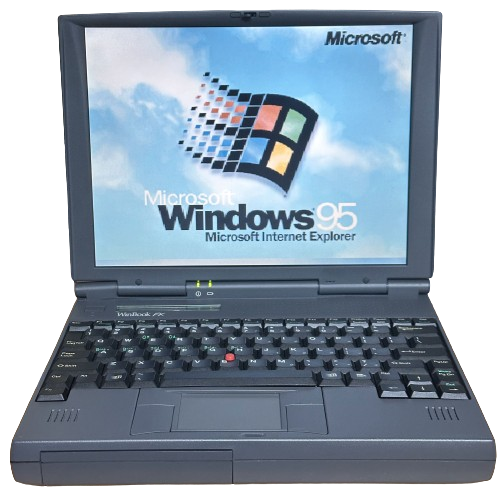
WinBook FX
The WinBook FX was a series of high-end Pentium laptops, released in May 1996 and sold into at least late 1997. The FX was WinBook's first laptop with a built-in CD-ROM drive. Like many other laptops of the time, the FX used a modular bay design to allow you to swap the CD-ROM drive out for a floppy, or a second battery. The FX was manufactured by Quanta, not WinBook themselves. WinBook only branded the unit and distributed it. AST sold the same laptop as the Ascentia P Series, and IPC's Austin sold it as the Edge.
Revisions
There were three revisions of the FX - the MP5, MP6, and MP7. WinBook never made clear what the difference between an MP5 and an MP6 is, but they grouped the two together for anything related to specs. I suspect it's that the MP5 was the earlier revision case design and that the MP6 was the later one (see the gallery section below for what I mean - there were clearly two similar but different FX case designs). The rest of this page goes off the assumption that that is the difference between the MP5 and MP6, but just know that this is not confirmed.
I believe the MP5 was the only version available with 11.3-inch displays.
The MP7 shares mostly the same case as the MP6, but used different video and sound chips (see specs below).
The MP5/MP6 specsheet lists the Pentium 150 as the fastest supported processor, and the Pentium MMX 166 as the fastest and only processor on the MP7 specsheet. Despite this, I have seen both MP5 and MP6 laptops with Pentium MMX 166 CPUs, so they were clearly also supported in the earlier revisions.
I believe the MP6 and MP7 designs may have been semi-custom for WinBook, at least more so than the MP5. The other laptops that used the same base Quanta design as the FX seem to be based on the MP5 revision.
Identifying your FX's revision
The easiest way to identify your FX revision is to cross-check with the photos in the gallery section below. If you have the early case design, it's an MP5. If you have the later case, check the bottom - the MP7 has substantially more cooling vents than the MP6. All MP7 serial numbers start with the letter Q - another quick way to tell (this is the number on the barcode sticker on the bottom, NOT the "Serial No." field on the main WinBook FX sticker). Lastly, if your FX has C&T video and ESS sound, it's an MP7.
Parts compatibility between revisions
- RAM, modular bay drives, ac adapters, and main batteries are the same for all FX revisions.
- Plastics differ between all three. No MP5 plastics will fit an MP6 or MP7, but some MP6 and MP7 plastics may be exchangeable.
- The MP5 uses different pointing device modules that will not fit the MP6 or MP7, which should use the same modules. Same goes for keyboards.
- The motherboard from the MP5 and MP6 may be exchangeable, but this isn't certain. I have no clue if the MP7 board fits in an MP5/MP6 or vice versa.
- I believe the MP7 uses a different hard drive caddy from the others - not sure if the actual adapter in the caddy is different though.
Specifications
| Spec | MP5/MP6 | MP7 |
|---|---|---|
| CPU Options | - Socket 7 - Intel Pentium @100, 120, 133, or 150MHz - Intel Pentium MMX @166MHz |
- Socket 7 - Intel Pentium MMX @166MHz |
| RAM | - 8MB soldered - Up to 72MB supported - 2 proprietary slots |
- 16MB soldered - Up to 80MB supported - 2 proprietary slots |
| Hard Disk | IDE 2.5" - Uses proprietary adapter PCB - 810MB, 1.0GB, 1.3GB, 1.4GB, 2.0GB, or 3.0GB Standard |
|
| Display Options | - 11.3" Active Matrix LCD @800x600 - 12.1" Active Matrix LCD @800x600 |
12.1" Active Matrix LCD @800x600 |
| Graphics Chipset | Cirrus Logic GD7543 or GD7548 - 1 or 2MB VRAM |
Chips & Technologies 65550 - 2MB VRAM |
| Audio | Creative Labs Vibra 16 (CT-2505) - Stereo Speakers |
ESS AudioDrive 1878 - Stereo Speakers |
| Main Battery | Primary: Lithium Ion, 12-cell, 14.4V, 3900mAH, Sanyo or Panasonic 18650 Cells Secondary (Modular Bay): Lithium Ion, 8-cell, 14.4V, 2600mAH, Sanyo 18650 Cells |
|
| CMOS Battery | - Soldered 1220-style Lithium (CMOS Battery) - 6-cell VARTA NiMH (Reserve/Suspend) |
|
| Power Supply | - Barrel Jack - 19V 2.3A |
|
| Disk Drives | WinBook FX/XP5 Pro Modular Bay - Supports CD-ROM (4, 6, 8, 10, or 12X) (TEAC or Toshiba), 3.5" 1.44MB Floppy Drive (TEAC), or 2nd Battery (Sanyo) | |
| PC Cards | - 2x PCMCIA Slots (2x Type 1/II, 1x Type III) - Type I and Type III can be used simultaneously - Cirrus Logic PD6730 Controller |
|
| Networking | Internal Modem (Rockwell) | |
| I/O (Front) | Battery Bay | |
| I/O (Right) | Modular Bay, PCMCIA Slots, Modem | |
| I/O (Rear) | Parallel, Serial, VGA Out, Dock Connector, Infrared, Mic In, Line In, Headphone Out, PS/2 | |
| I/O (Left) | HDD Bay, DC Jack, Lock slot, Game Port | |
| BIOS | - Phoenix - Supports APM 1.0 and 1.1 |
|
| Pointing Device | - TrackPoint (Standard) - Optional Trackpad |
|
| FCC ID | HFSMPX | |
Resources
 Drivers |
 User Manual |
Archived Support Pages |
|---|
Common Faults & Maintenance
The WinBook FX laptops are overall pretty decent for reliability compared to many other laptops from the time, however, there are a few issues to take note of.
VARTA Hiberate Battery
The FX has an internal 6-cell VARTA battery that is used as a "hiberation" battery (allows the computer to stay alive in sleep mode for a main battery swap). This battery is incredibly prone to leaking with age, and should be removed ASAP on any WinBook FX. It is located under the left palmrest, thankfully a ways away from the motherboard. It is very close to the left side speaker and its ribbon cable though, so a leak could damage that.
Sound Failure & Solder Quality Problems
The FX suffers from poor quality soldering. Most often, this causes the sound card to stop working. The sound chip will still show in device manager but will fail to initialize and show an error. This issue is extremely common. To fix it, simply take the FX apart and reflow the chip with a hot air station or soldering iron. I'd recommend completely removing the chip and using new solder to reinstall it if you have the skill to do that. If not, a reflow will suffice. This problem has so far only been brought up on the FX MP5 and MP6 revisions with the Vibra 16 sound chip. It is currently unknown if the MP7 revision with an ESS sound chip is affected. On the MP5/MP6, the Vibra chip is located under the PCMCIA slots.
Additionally, compaqportableplus on the VCF Forums had a stay bit of solder cause a short preventing his AST Ascentia P from starting (The Ascentia P is the exact same laptop under a different brand name).
Brittle Plastic
Like close to every 90s laptop, the FX is quite brittle. The hinge mounts are actually pretty decently made, I've seen far worse. They aren't trouble-free though. The metal hinge itself snapped on my FX, and I've seen a couple on eBay that had cracked plastic on the display housing around the hinges. Failures are less common on these than average though.
It is impossible to take the display housing apart without breaking a large number of the clips that hold it together. Avoid taking it apart unless you absolutely have to (I had to because the LCD cable came loose), as it won't go back together right after.
Other Notes
This system uses proprietary RAM, which will make upgrades very difficult to find.
They use a standard barrel power plug and voltage.
The modular bay drives are interchangeable with the WinBook XP5 Pro.
The hard drive uses a proprietary interposer/adapter like most laptops with modular IDE drives do. Avoid buying one that's missing the drive, unless the seller states that they saved this adapter.
There are no electrolytic caps in the lower half of the unit. I'm not entirely sure if the display has them or not.
Like any laptop from this time, the LCDs can become affected by Vinegar Syndrome.
Gallery
Click on an option below to view images.
1st Revision (MP5)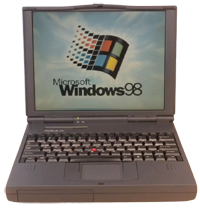
|
2nd Revision (MP6)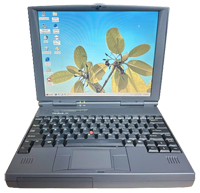
|
3rd Revision (MP7)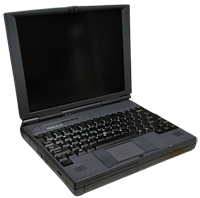
|
Mini-Dock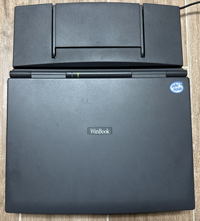
|
Box & Documentation
|
Print Ads
|
Page last updated (MM/DD/YYYY): 08/28/2024
Update Reason: info on revisions updated
Back-Navigation
Index < Home < Laptop Portal < WinBook < FX